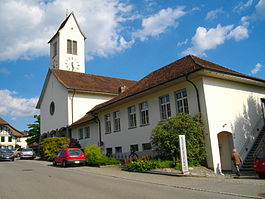- Muri bei Bern
-
Muri bei Bern Country Switzerland 
Canton Bern District Bern-Mittelland 46°56′N 7°29′E / 46.933°N 7.483°ECoordinates: 46°56′N 7°29′E / 46.933°N 7.483°E Population 12,625 (Dec 2010)[1] - Density 1,640 /km2 (4,247 /sq mi) Area 7.63 km2 (2.95 sq mi)[2] Elevation 558 m (1,831 ft) Postal code 3074 SFOS number 0356 Mayor Hans-Rudolf Saxer (as of 2008) FDP/PRD Surrounded by Allmendingen, Belp, Bern, Kehrsatz, Köniz, Ostermundigen, Stettlen, Vechigen and Worb Website www.muri-guemligen.ch
SFSO statisticsMuri bei Bern is a municipality in the Bern-Mittelland administrative district in the canton of Bern in Switzerland.
The municipality is clearly divided into two parts, each with about 6,000 people. The towns are known as Muri, which has been the name of the municipality for a long time, and Gümligen.
Contents
History
Archaeological finds at Schlosshügel, unearthed in 1832, show that Muri was already settled in the era of the Roman Empire. The earliest documentary evidence for the name was in 1180, when a clergyman named Burkhard made transactions with wealthy residents.
At that time Muri belonged to the dominion of Geristein, which in 1298 was conquered by the city of Bern. The holdings consisted of the four so-called parishes Bolligen, Muri, Stettlen, and Vechigen. As the emerging Bern conquered the territories, it left the municipalities untouched, beginning the long-standing tradition of municipal autonomy.
In the course of the centuries the residents of the municipality lived in relative stability, in which the major changes in European and Swiss history seemed to pass them by. Major structural and commercial changes began to take place in the beginning of the 20th century. It followed industrialization and the trains from the city to the countryside. In the decade between 1920 and 1930, the municipal population grew from 2435 to 3938, or 62%.
Geography
The municipal area of 7.7 km2 (3.0 sq mi). This consists of 1.5 km2 (0.58 sq mi) or about 21.3% forest, 1.90 km2 (0.73 sq mi) or about 28.9% agricultural land, and 3.39 km2 (1.31 sq mi) or about 47.7% developed land. The remainder (2.1%) is non-productive (rivers or glaciers).[3] The highest point is 727 m (2,385 ft) on the Dentenberg Mountain; the lowest point is 508 m (1,667 ft) at the Aare River.
Notable sights and recreation
- Aarebad Muri, popular site for swimming
- Muri Castle (privately owned)
- Gümligen Castle (privately owned)
- Villa Mettlen, country estate
- Muri Church, a Swiss Reformed Church
- Auguetbrücke, bridge across the Aare finished in 1836.
- Natural Protected Area along the Aare
- Between Belp and Köniz there are still ferries between Bern and Thun along the Aare
Demographics
Muri has a population (as of 31 December 2010) of 12,625.[1] As of 2007[update], 10.8% of the population was made up of foreign nationals. Over the last 10 years the population has decreased at a rate of -1%. Most of the population (as of 2000[update]) speaks German (88.9%), with French being second most common ( 3.0%) and English being third ( 1.5%).
In the 2007 election the most popular party was the FDP which received 31.5% of the vote. The next three most popular parties were the SVP (23.6%), the SPS (17.7%) and the Green Party (12.9%).
The age distribution of the population (as of 2000[update]) is children and teenagers (0–19 years old) make up 18.2% of the population, while adults (20–64 years old) make up 61.3% and the seniors (over 64 years old) make up 20.5%. In Muri about 84.4% of the population (between age 25-64) have completed either non-mandatory upper secondary education or additional higher education (either university or a Fachhochschule).
Muri has an unemployment rate of 1.46%. As of 2005[update], there were 107 people employed in the primary economic sector and about 17 businesses involved in this sector. 1638 people are employed in the secondary sector and there are 116 businesses in this sector. 4642 people are employed in the tertiary sector, with 545 businesses in this sector.[3]
Politics
The greater municipal council is the legislature of the municipality. It has 40 members, elected every four years by proportional representation.
The municipal council is the executive. It has seven members. With the exception of the mayor, the other members keep other jobs. The council is chosen every four years at the same time and in the same manner as the greater council. The mayor is chosen by majority.
Economy
In January 2003 the trade and industry association of the canton of Bern ranked 51 major municipalities in the Bern metropolitan area and Biel-Seeland region according to favorable economic practices. Muri led the list, followed by Lyss and Belp. Muri is known as a tax haven within the canton.
Space for new enterprises is being made available with authorized construction plans. The areas designated Gümligen Station and Gümligen Field are currently centers of development within the canton.
Education
Within the municipality there are six primary schools. There are also two private schools, which conduct classes in English.
Further reading
- Muri bei Bern: eine Gemeinde, zwei Dörfer, ed. by the municipality of Muri bei Bern, 1993
References
- ^ a b Swiss Federal Statistical Office - STAT-TAB, online database – Datenwürfel für Thema 01.2 - Bevölkerungsstand und -bewegung (German) accessed 29 September
- ^ Arealstatistik Standard - Gemeindedaten nach 4 Hauptbereichen
- ^ a b Swiss Federal Statistical Office accessed 29-May-2009
External links
- Official website (German)
- Website of Villa Mettlen (German)
- Bärtschihus recreation and youth center (German)
Categories:- Municipalities of Bern
- Municipalities of Switzerland
- Cities in Switzerland
Wikimedia Foundation. 2010.



